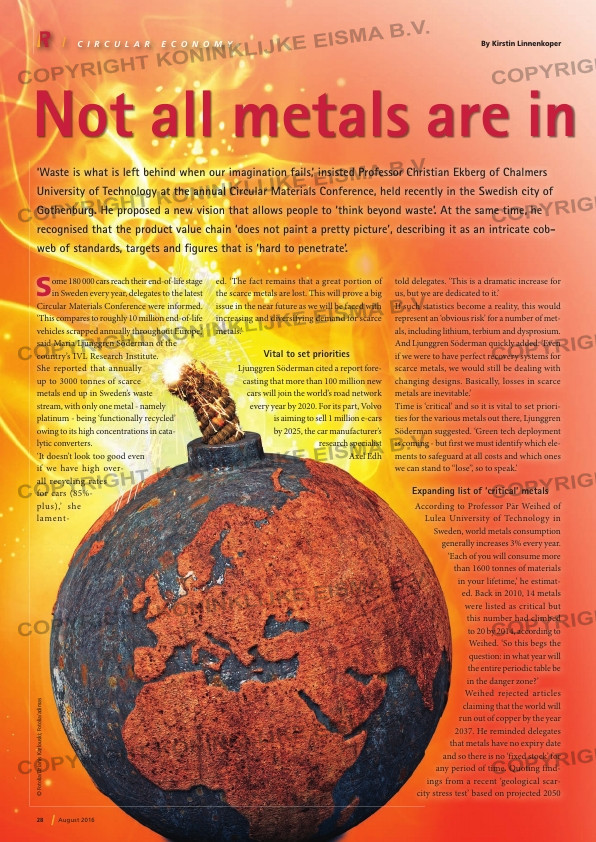Page 28 from: August 2016

28 August 2016
C I R C U L A R E C O N O M Y
‘Waste is what is left behind when our imagination fails,’ insisted Professor Christian Ekberg of Chalmers
University of Technology at the annual Circular Materials Conference, held recently in the Swedish city of
Gothenburg. He proposed a new vision that allows people to ‘think beyond waste’. At the same time, he
recognised that the product value chain ‘does not paint a pretty picture’, describing it as an intricate cob-
web of standards, targets and figures that is ‘hard to penetrate’.
Some 180 000 cars reach their end-of-life stage in Sweden every year, delegates to the latest
Circular Materials Conference were informed.
‘This compares to roughly 10 million end-of-life
vehicles scrapped annually throughout Europe,’
said Maria Ljunggren Söderman of the
country’s IVL Research Institute.
She reported that annually
up to 3000 tonnes of scarce
metals end up in Sweden’s waste
stream, with only one metal – namely
platinum – being ‘functionally recycled’
owing to its high concentrations in cata-
lytic converters.
‘It doesn’t look too good even
if we have high over-
all recycling rates
for cars (85%-
plus),’ she
lament-
ed. ‘The fact remains that a great portion of
the scarce metals are lost. This will prove a big
issue in the near future as we will be faced with
increasing and diversifying demand for scarce
metals.’
Vital to set priorities
Ljunggren Söderman cited a report fore-
casting that more than 100 million new
cars will join the world’s road network
every year by 2020. For its part, Volvo
is aiming to sell 1 million e-cars
by 2025, the car manufacturer’s
research specialist
Axel Edh
told delegates. ‘This is a dramatic increase for
us, but we are dedicated to it.’
If such statistics become a reality, this would
represent an ‘obvious risk’ for a number of met-
als, including lithium, terbium and dysprosium.
And Ljunggren Söderman quickly added: ‘Even
if we were to have perfect recovery systems for
scarce metals, we would still be dealing with
changing designs. Basically, losses in scarce
metals are inevitable.’
Time is ‘critical’ and so it is vital to set priori-
ties for the various metals out there, Ljunggren
Söderman suggested. ‘Green tech deployment
is coming – but first we must identify which ele-
ments to safeguard at all costs and which ones
we can stand to “lose”, so to speak.’
Expanding list of ‘critical’ metals
According to Professor Pär Weihed of
Lulea University of Technology in
Sweden, world metals consumption
generally increases 3% every year.
‘Each of you will consume more
than 1600 tonnes of materials
in your lifetime,’ he estimat-
ed. Back in 2010, 14 metals
were listed as critical but
this number had climbed
to 20 by 2014, according to
Weihed. ‘So this begs the
question: in what year will
the entire periodic table be
in the danger zone?’
Weihed rejected articles
claiming that the world will
run out of copper by the year
2037. He reminded delegates
that metals have no expiry date
and so there is no ‘fixed stock’ for
any period of time. Quoting find-
ings from a recent ‘geological scar-
city stress test’ based on projected 2050
By Kirstin Linnenkoper
Not all metals are in ‘the danger zone’
©
F
ot
ol
ia
/D
zi
an
is
K
az
lo
us
ki
; F
ot
ol
ia
/a
di
m
as



